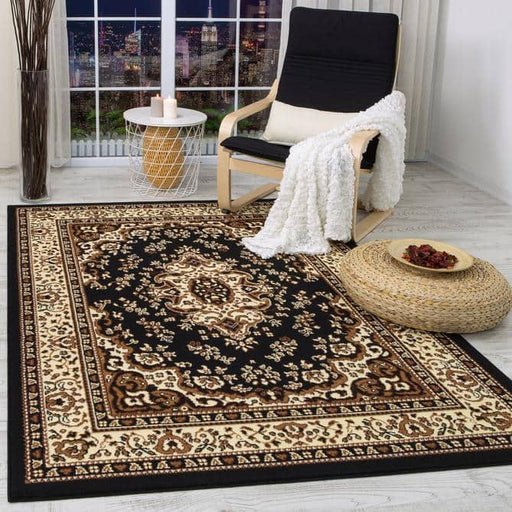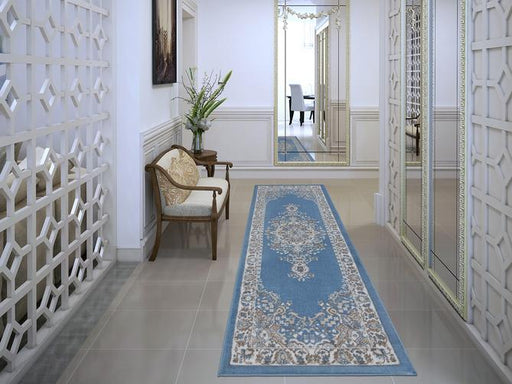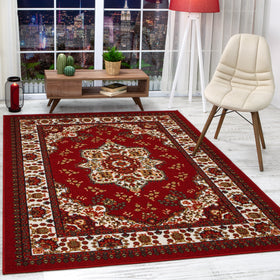Oriental Area Rugs
-

 Sale
from $34.85
Sale
from $34.85Antep Rugs Alfombras Oriental Traditional Non-Skid (Non-Slip) Low Profile Pile Rubber Backing Indoor Area Rug Perfect for Dining Room, Living Room,...
View full detailsfrom $34.85Sale -

 Sale
from $35.85
Sale
from $35.85Antep Rugs Kashan King Collection Oriental Indoor Area Rug Add a fashionable complement to a living room, dining room or bedroom with this versatil...
View full detailsfrom $35.85Sale -

 Sold out
from $29.85
Sold out
from $29.85Antep Rugs Siesta Collection Oriental Traditional Indoor Area Rug Add a fashionable complement to a living room, dining room or bedroom with this v...
View full detailsfrom $29.85Sold out -

 Sale
from $25.99
Sale
from $25.99Antep Rugs Oriental Traditional Medallion Indoor Area Rug Perfect for Dining Room, Living Room, Bedroom. Spot clean with mild soap. Vacuum Regularl...
View full detailsfrom $25.99Sale -

 Sale
from $49.85
Sale
from $49.85Antep Rugs Elite Vintage Bohemian Distressed Oriental Medallion Indoor Area Rug Perfect for Dining Room, Living Room, Bedroom. Spot clean with mild...
View full detailsfrom $49.85Sale
Oriental rugs are known for their richly varied designs, but common traditional characteristics identify the design of a carpet as “oriental”. Rug design originates from a two-dimensional arrangement of knots in various colours. Each knot tied into a rug can be regarded as one "pixel" of a picture, so the intricacy can be felt looking at it.
Oriental rug design is described either as rectilinear (geometric), or curvilinear (floral). Curvilinear rugs show floral figures in a realistic manner. The drawing is more fluid, and the weaving is often more complicated. Rectilinear patterns tend to be bolder and more angular. Floral patterns can be woven in rectilinear design, but they tend to be more abstract, or more highly stylized.
An Oriental rug is best used to describe rugs that are made in the Asian continent. These types are rugs normally originate from Russia, Pakistan, India, Turkey, Tibet, China & Iran.
Rug design can also be described by how the surface of the rug is arranged and organized. One single, basic design may cover the entire field. When the end of the field is reached, patterns may be cut off intentionally, thus creating the impression that they continue beyond the borders of the rug. With minimized the bezel area, some authentic oriental rugs can fill the floor as if reaching out to your home.
Designs of Element in Oriental Rugs
Almost all the significant designs on traditional oriental rugs are Persian designs which have been adopted by other rug weavers throughout the time. Persian rugs, however, have adopted a certain element of designs from other regions for different purposes. For instance, during the early 19th century, Persian rugs became a commodity that found a new market in Europe and later on in North America. During that time some Iranian rug weavers adopted a policy of accommodating the western fashion taste. They started incorporating some of the western architectural element in their designs or weaving rugs with French Aubusson resins as well as incorporating some western floral patterns that became known as Golfarang or western floral.
There is one exception to the oriental rugs designs in terms of their origin. China indeed had its own distinct designs in their hand knotted oriental rugs. More open filed with floral Aubusson type borders, either with or without a medallion, as well as dragon designs in hand knotted oriental are original chines designs. However, as the western market opened up for Persian hand knotted rugs, Chinese weavers moved towards adopting more and more of Persian motifs and designs.
The Persian carpet or Persian rug is an essential and distinguished part of Persian culture and art, and dates back to ancient Persia. Decorating with vintage rugs and antique carpets is the latest trend to excite interior decorators and their customers seeking unique alternatives to one-dimensional decor concepts. What is so remarkable about richly colored and exotically designed antique rugs is their ability to blend seamlessly with nearly any type of décor — especially contemporary spaces. Timeless and versatile, rugs and antique carpets offer the ability to unify disparate features of any type of décor due to their inherently centralized compositions. Providing a decorative base essential to optimizing specific interior design principles, oriental rugs embody contemporary, modern and historical elements of balance, harmony and beauty. Decorating with vintage rugs and antique carpets can be fun, exciting and inspiring, leading to originality and freshness of ideas when re-inventing or reinvigorating a room’s ambiance.
Floral Persian designs themselves have a much different variety of design combinations which will be separately discussed under hand-knotted rug designs. What is important to keep in mind is that rug weaving traditions have constantly influenced one another in different aspects such as designs and use of color or dyeing technics. Even within Iran itself different rug-making regions have had their impression on the neighboring regions while asserting their own identity elements.
Colors in Oriental Rugs
Another distinct characteristic of traditional rugs is the use of certain colors and color combinations. To make it more clearly, some of the colors used in modern rugs or the combination of certain colors is what makes the traditional rugs different from the Modern or Traditional rugs. The colors used in these Traditional rugs are almost similar to each other and includes black, rusty red, navy blue, brown, white and maroon. Most traditional rugs have darker tone except they have been made for a particular purpose
Geometric Designs in Oriental Rugs
In terms of the broader categorization with respect to authentic oriental rug designs, two different types of designs are noteworthy which are known as floral designs and Geometric designs. Unlike floral designs which have smooth curves and turns and softer turns and circular and semi-circular patterns, geometric designs have a corner and sharp turns and angles in the motifs. Geometric designs are generally composed of geometric shapes combined together forming the motifs.
Even floral motifs in geometrics are with angles corners and not smooth circular turns. Geometric designs in traditional rugs although have their roots in the tribal rugs, have been one of the most popular designs in traditional rugs throughout the last 2oo years. Particularly famous Heriz rugs and the finer version of Persian Heriz rugs known as Serapi rugs, with their marvels fine geometric designs gained popularity among western nations particularly in US and Europe starting with the 19th century.
Traditional rug category could include Persian rugs, Turkish rugs, Afghani Rugs, Pakistani rugs, Indian rugs. each of these regions consists of many different sub-categories such as Persian Kashan rugs, karastan oriental rugs and kaouds oriental rugs.
How to keep them fresh?
Oriental rug cleaning isn't just about getting rid of the dirt, soil and debris that resides on the surfaces. It's also about keeping the rugs' structure and natural fibers in great shape. If you get your Oriental rug professionally cleaned on a regular basis, you can help keep it in strong condition for years and years on end. It's generally a smart idea for oriental rug owners to get their rugs professionally cleaned in intervals of every 4 to 5 years.
FAQs
The most well-known feature of oriental rugs is the fact that they are hand-knotted in Asia. The most popular countries that make oriental rugs are Iran, Turkey, India, Pakistan, Tibet, Nepal, Russia, and China. Persian rugs are also oriental rugs but they are made exclusively in Iran (formerly known as Persia).
First, remove the loose dirt by vacuuming your oriental rug. Be careful to not vacuum the edges as this can damage your rug. Continue by dusting your oriental rug and vacuuming it once again. Afterward, soak the rug with cold water and begin washing it with rug shampoo. Be careful to not scrub your oriental rug too hard as it can damage the fibers. Rinse and repeat this process as you did with vacuuming. Finally, find a spot where both sides of the rug can dry equally when hanging vertically.
When decorating your home with oriental rugs you can go with neutral or monochromatic colors. This will allow your oriental rugs to stand out and depict a unique atmosphere to your surroundings. Also, make sure to not be afraid when mixing different color palettes as bold designs are an important aspect of oriental rugs.












